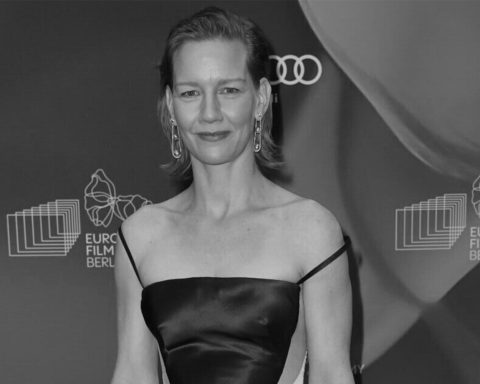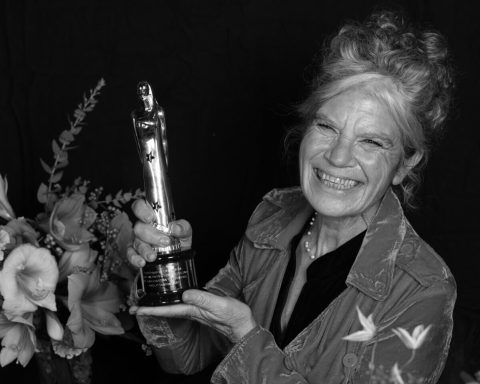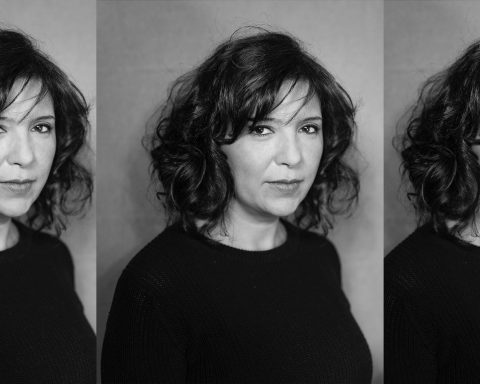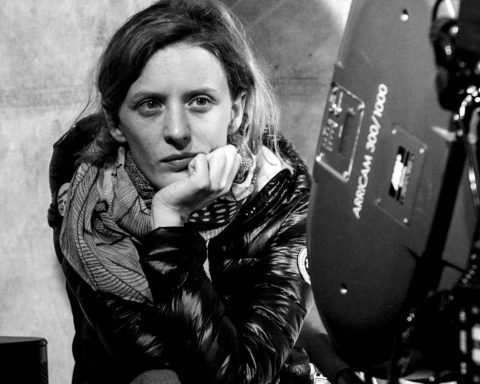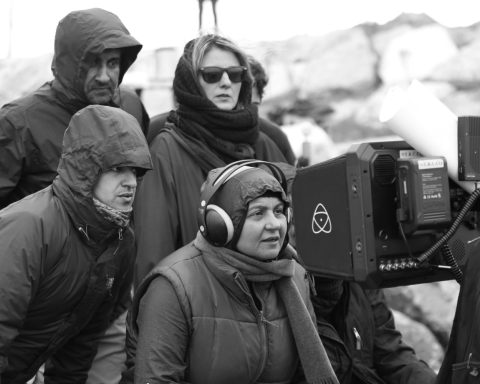Elen Lotman graduated summa cum laude from the Baltic Film and Media School with a BA in Cinematography and has shot numerous documentaries, short and feature films. For various film projects, she has travelled to Japan, Tibet, China, Thailand, India, Nicaragua, Costa Rica, Finland and the Russian Arctic. Since 2005, Elen has been teaching Cinematography at the Baltic Film and Media School, becoming in 2013 the Head of the Film Department and in 2015, the Head of Arts Study Area. Her PhD research focuses on aspects of human perception and cinematography. She is the President of the Estonian Society of Cinematographers (ESC) and a Member of the Board of IMAGO, the International Federation of Cinematographers.
Tara Karajica caught up with her at this year’s Black Nights Film Festival, where she was part of the WIFTI Talks organized within the framework of the festival.
Were films part of your childhood? If so, to what extent?
Elen Lotman: Surprisingly enough, not that much because, I have to say, I grew up in the turbulent end of the Soviet Union era and Western films actually only started coming to Estonia when I was in my early teens, so I grew up more inside books than films. But, later, thinking back about my childhood, I guess there was a bit of influence from my grandfather who was a semiotic scientist and who worked a lot in film semiotics, so I remember him talking about Antonioni’s Blow Up, but I think, for me, really what were the most influential films at a specific point were Cinema Paradiso and Delikatessen. These were the two films that when I saw them, I think something changed in me and because it was more or less the age when I was watching Home Alone, and these films were so different, so moving, so touching and so unique. And I think the idea of wanting to become a filmmaker somehow crept into my head because of them. But my parents are biologists and I grew up in a family of scientists, linguists and biology scientists, so this didn’t come naturally, but they were all very supportive. And I have to be honest, when I went to University, I really didn’t know who is the cinematographer, who is the director… I had no idea. And I didn’t have this classical way that usually cinematographers take a lot of photos, are members of photo clubs, etc. I probably hadn’t even held a photo camera in my hands when I was trying to get into film school. I was much more verbal than visual, which maybe slowed down my progression as a cinematographer a bit.
How did you decide you wanted to become a cinematographer, then?
E.L.: It was little bit different back then. When I graduated from high school, I had been a hundred percent sure I wanted to study filmmaking. But in Estonia, the film school opened in 1992 and for the first class, they didn’t have enough money to admit different specializations like you have now. Now, we have editing, cinematography, sound, directing, screenwriting and producing. So, we have six specialized courses plus production design. But back then, they only had money for one specialized course per intake. So what happened was that in 1992, they took fiction feature directors, then, four years later, they admitted documentary directors, then, two years later, they admitted sound designers. Right now, that seems funny, but at that time, whatever money they had, they used it as much as they could. So the situation of the film school was much tighter. When I graduated from high school, they were just admitting the new course, which was cinematography. So, you could say, looking back, it was more or less an accident because that year, they were just taking cinematography students and I wanted to go to film school, not really knowing what a cinematographer does. So I got in and, maybe, at first, it was an interesting course because they admitted twenty students and all of us were cinematographers and we were playing in each other’s films and directing each other’s films and it was a home grown film school at that point. But I think that somewhere around the second year, I understood that this was what I wanted to be – a cinematographer; that cinematography is where I feel the safest, or the best. Of course, it took a lot of time to find myself in cinematography because cinematography back then wasn’t much more feminine than it is now, so when I looked around at cinematographers I admired, I didn’t see any women, so it was hard to find yourself in something when you knew for sure that you need to make films, but you didn’t know if films needed you. Also looking back, maybe it’s one of the reasons why I actually agreed to get involved in our advocacy for women cinematographers within Imago with Nina Kellgren BSC.
I have to say, I am behind the camera because I don’t want to be in the spotlight and I never wanted to be some kind of example, but some years ago, accidentally, a correspondence that wasn’t supposed to come to me was forwarded to me: a letter where I saw one of my former students saying that here in Estonia we aspiring female cinematographers don’t really have anyone else to look up to except for Elen in cinematography. And this suddenly struck me; even if you don’t think you’re some kind of role model, but if you exist, you become one. And just then, we were discussing with Nina about the kind of outreach we want to do and one of the topics that we had been talking about was: “If you can see it, you can be it” and then I suddenly understood that if I didn’t want to be in the limelight, the fact that I exist can inspire some young girls to think about the same path. And I didn’t really know any female cinematographers back when I started. Aimée Beekman was an Estonian who graduated from VGIK as a cinematographer in the 1950s/1960s and became the head cinematographer of Tallinnfilm and probably was disenfranchised by the system, changing her path and becoming a writer. Many female cinematographers then just gave up because it was basically impossible. So at the beginning of the 2000s, when I started, there weren’t any female cinematographers in the Estonian film industry to see and to be encouraged by seeing them work and maybe that’s one of the reasons why I am doing this outreach.
Can you talk about the outreach you are doing with Imago and Nina Kellgren?
E.L.: This all actually started with Nina Kellgren who is also on the Board of Imago with me. She is a BSC member and a wonderful cinematographer. By the way, through the data from the BFI filmography and a project that explored gender balance from the beginning of British film industry, she turned out to be the most prolific female cinematographer in British film history, which is great. And on that list, she is there with eight feature films I think, which says a lot, compared to many male cinematographers who manage to shoot fifty feature films during their career. I know her well and knowing her talent, resilience and unique vision I am a hundred percent convinced that she could have shot fifty films too, if the gender balance in cinematography hadn’t been as appalling as it is. Anyway, Nina is an unstoppable force. When she became a Board member of Imago and during one of our first Board meetings when I was actually out of the room, she proposed to the rest of the Board that we form a committee for Diversity and Inclusion and start working on this, and all the Board was very enthusiastic, which I am very happy about. And when I came back into the room, she said: “Elen, we are going to do this work.” So we started with the Diversity and Inclusion Committee.
Our main events have taken place at the Camerimage Film Festival because it’s the place where everybody goes to in the cinematography world. So, for four years we have been organizing an event whose focus has been showcasing both gender and minority issues – basically, representation – because the world of cinematographers doesn’t really represent the complexity of the real world and cinematography’s, actually, I think, one of the most white male worlds in film. It’s changing everywhere; in screenwriting or directing, it’s becoming more balanced, but in cinematography, it’s still very traditional. And one of the things we found when we were planning one of the first events was that the numbers are a little bit depressing because what has changed is that more and more girls are being admitted into film schools, which is good – it’s almost half and half in Western European countries – but then women start disappearing at some point, because of family choices or just because they are not seen as trustworthy by the producers. The higher the budgets go, the less and less women I see and in the world of high end, big budget films, there is a very, very small number of female DOPs.
Now, a big shot in this world is Rachel Morrison who, I think, has made a huge difference. We had her in our panel at Camerimage twice and we’re very, very happy that she supports this. She’s been with us along the way. So going back to showcasing, we have been doing a lot of masterclasses to change the unconscious bias. One of the goals the first feminist thinkers had is that the idea of female movements should be to make themselves redundant. In that sense, our goal is the same. The day we don’t feel we need to speak about this issue anymore, we’ll be like: “Yeah!” because no cinematographer wants to be a female cinematographer; everybody just wants to be a cinematographer. So, in that regard, we’ve been mostly focusing not on gender issues per se, but on masterclasses. We had a fantastic masterclass with Charlotte Bruus Christensen who is this absolutely amazing cinematographer. Plus, she has three kids and two of them are twins. She shot The Hunt when she was expecting her first child and Far from the Madding Crowd when she was expecting her twins. She’s marvelous! We had a fantastic masterclass with Natasha Braier on The Neon Demon. Then also, Rachel Morrison spoke about making it to the next level in a discussion organized by Illuminatrix, the female DOPs in UK network. In addition to these masterclasses, we had panel discussions on the topic of representation and it seems that we were the first to bring this issue up in the Camerimage program. During these four years, we have been organizing the Diversity and Inclusion events at Camerimage and we’ve had fantastic panelists. Ed Lachman, Natasha Braier, Ula Pontikos, Roberto Schaefer, Bradford Young, etc. We had Nancy Schreiber who is the legendary trailblazer for all female cinematographers. The second year, we looked into institutions and what they can do and two years ago, we had a very interesting panel on career and private life choices because this is the show stopper for so many women. We had Rachel, who had just had her second child, and Sophia Olsson who is a very successful Swedish DOP shooting everywhere internationally and who has a son and is raising him as a single mother. We had also Claire Pijman, a Dutch DOP who has three children and she had just finished a film about Robby Müller, “Living the Light”, which is fantastic because it also speaks about the loneliness of cinematographers. It’s not only men and women; it’s the job that makes you be away for so long. You are away from your family for so many days during the year and when you watch that film, you see that Robbie is away from home most of the time and is always in hotel rooms and somewhere in the background his children are growing up. So I found that this discussion resonated with both men and women equally. And then, we had Jendra Jarnagin who talked about her choice of not having children because of her career. So we had different layers of this issue and I was very inspired by the talk and I felt that we somehow crossed this female issue and we talked about everybody’s issue and this is something we have been talking with Nina from the start: this is not just women’s problem, it’s everybody’s problem and the audience definitely has a lot to gain from the fact there is more diversity among cinematographers.
If it’s not too much of a personal question, how do you balance your work and family life as a female cinematographer and a mother?
E.L.: Finding a balance wouldn’t, of course, be possible without my partner, Madis; he’s my pillar. Of course, there are people who actually raise children alone, so, I can’t say it would be absolutely impossible, but it would be incredibly hard and I’ve been extremely lucky that we are working as a team in terms of having children and careers. When you make a film, the team effort is probably the most rewarding part, and I think the same goes for the family, too. And I’ve been extremely lucky with my three kids. They are really cool. I consider them more as my companions in the world; maybe I am more like this companion type of parent myself, I am not very “parenty,” so they hang around on set if they can and sometimes they are extras in some films. I would say that having a family as a female cinematographer requires juggling, but it’s possible.
Going back to the lack of female influences in cinematography. Can you name some that have made a difference for you?
E.L.: I think that just in terms of inspiration, you don’t really look for people who are your gender, you just look for people who are inspiring in the work they do. But I think your gender becomes an issue when you are trying to see yourself in the picture. So it’s easy to admire someone, but if you don’t see anyone looking like you, it might be hard. But for me, actually, I have to say, the biggest game changer was a male cinematographer. I had just graduated from University and I was kind of lost in the sense that I had been working for a while as an electrician and a freelance camera assistant and when I looked around, I only saw middle-aged, very calm, very composed, very quiet men around me in the cinematography world. And when I looked in the mirror, it wasn’t what I saw. So, in a way, maybe subconsciously I was trying to change myself or act differently or be less loud. And then in 2004, I was at the Berlinale Talent Campus and Christopher Doyle was giving a lecture there. Of course, like everything he does, it was a big show and a concert hall full of people and when we finished, they all flocked around him and I decided not to because I have never known how to do the fangirl thing. A little later, I was just waiting outside for my friend and, suddenly, Chris is next to me and it’s just the two of us and I say: “Hello” and that I really admire his work especially on In the Mood for Love and Hero and ask if it would be possible to learn from him or shadow him and he says: “Yes, sure. I am shooting in Thailand in a couple of days, you can come.” So, at that time, I didn’t have anything; I was a recent graduate, so I came back to Estonia and gave up the apartment I was renting. I didn’t have any money, but for some weird reason, the bank gave me a credit card, so I bought a one-way ticket to Bangkok and I flew there and I didn’t know where I was going or what I was doing, but I trusted Chris. Then, I ended up being his apprentice on a film called Invisible Waves for two months. Actually, originally, I thought I would be the assistant, but the Thai crew they had was working so well that they didn’t really need any assisting, but I was just there watching him work. We shot in Bangkok, Macau, Hong Kong, Pukhet, just a couple of months after the 2004 tsunami, so for me, the whole trip was a huge life changer both in the fact that you live in a completely different culture, but also when I was looking at him, I thought he was as himself as one can be; he’s completely a hundred percent himself every single waking moment. People can like him as he is or not, but he is unapologetically himself. You can hate him or love him, but you see he is who he is. And when I was there, I had time to think about it and I finally understood that in this big world, there is only one thing I know for sure that I can be better at than anyone else, and that’s being myself. That’s the only thing. Everything else probably someone else can do better. Being myself is the only thing I can do best. So after this, of course, I had my insecurities, and my life didn’t change with a snap of the fingers, but I started to try and understand who I am more and more and what I have to offer as myself and try and be less someone else. In that sense, I think Chris Doyle has been for me the most influential cinematographer through his work, but also through his person.
Another person who has influenced me as a filmmaker more than anyone else is my good friend, director Tanel Toom. He is the most resilient, hard working and never-settling director, a total perfectionist who never surrenders. And, of course, he is also talented, but I do believe that talent is overrated and the will to always work to make your creation better overweighs any talent. I admire him a lot and he inspires me to always move forward, and to never settle.
There has been so much talk about the place of women in film in the past year, can you talk about that? + Estonia?
E.L.: In order to see the big picture changing, you need a bit more time and distance. Very often, when you notice change, it really fluctuates. One year, in Estonia, for example, we had a huge amount of female directors, feature debuts, all women. It felt like a big change. That year, 2016, I was commissioned by the Estonian Film Institute to do a presentation about gender balance in the Estonian film industry at the Eurimages meeting in Estonia. With the help of the data provided by the Estonian Film Institute, I did a survey of films made from 2012 to 2016 in Estonia, which is a small country, so the numbers really can fluctuate a lot, and it was quite clear how the numbers went up on the years I shot a feature and when I wasn’t, they went down to zero. There were years when sixteen percent of feature films were shot by women, which would be a very high number in the world scale considering that in general the percentage of female cinematographers is around four percent or less but this sixteen percent was actually just me when I was shooting. So nothing really to be so happy about. The numbers are a little bit tricky, so it’s a bit hard to look at them very closely. There is this interesting paradox described by Lewis Richardson, which is called the coastline paradox that basically says that when you look at the map of a coastline from afar, the border is very clear, and the closer you go, the fuzzier it gets and if you look at it from one meter, there is no difference between the sea and the coastline; it’s all just moving waves and sand. So I think that when we look at the numbers from really close, it might feel that one year we have made huge steps forward and the next year, it’s like: “Where are all the women?” Overall, at least in Western Europe and in the Anglo-American film world, I think it is changing, especially because I think some of the women whose voices may be more heard, like those of actresses because of our star-prone society, have started to talk about it. Like Carey Mulligan with her child care on set… These women whose voices are heard more will pull the rest up, the below the line crew whose voices are maybe less heard. But I think the most important change should happen not only on the gender balance line, but generally in representation. Each country and culture has its minorities that are disenfranchised, present in society, but their voices unheard. What the society at large needs is a film industry that represents the real and diverse nature of all its members, not just a select slice of society.
What is your favorite film that you shot? Why? What did you learn from that experience?
E.L.: That’s a hard question! I always think that my favorite film is my next film! And this is not to say anything about the filmmakers I work with because I really love teamwork, and I really respect the filmmakers I have worked with, but I am never satisfied with myself. From the moment I finish a film, I already feel that I could’ve done so much better, so I hope it’s a good sign because it means I am developing.
How do you choose your projects?
E.L.: I consider myself a very bad cinematographer. This is one of the things that has influenced me a lot because I am so bad at gut-feeling-instinctive-shooting and I am so bad at just being cool, it takes a lot of love for me to go into a project and care for the people and the story, so that’s why I don’t almost shoot commercials at all. Maybe I’ve shot about ten commercials in my whole life because I don’t have the instincts that you need to be a good commercial cinematographer, so this leaves me with mostly features and documentaries and sometimes TV. Usually, when you get a feature offer, you’re just very happy to do it, so you very rarely turn it down and when you turn it down, it’s when you really see that either it’s completely impossible to do because the budget is so low that you see this will basically be based on slave labor, or if you can see there are so many issues with the team or the script. In documentaries, usually the topic is what I really do care about and I have traveled a lot, shooting documentaries all over the world, so I am a global citizen and the ethical choices I make are important. It would be very hard for me to shoot something that wouldn’t contribute to the overall well-being of the world.
Who is your favorite female filmmaker? And film by a female filmmaker?
E.L.: If I have to pick someone close to my heart, then it’s Moonika Siimets. She’s an Estonian film director and a good friend of mine. I really, really like one of her short films, The Last Romeo, which is a musical. It’s so funny and so raw, so interesting and so different. It’s a contemporary musical that takes place in a very small village in Estonia, so there is a clash of almost social-realistic images and the musical and it’s just a wonderful film.
Who would you like to work with?
E.L.: When I watched Point Break as a kid, I didn’t know back then who was the director or the cinematographer, but I loved this film. Later, I learnt it was made by Katheryn Bigelow, and then I saw her later films like The Hurt Locker and I always dreamt of doing high action movies and, in this life, if I had the chance to work with her on an action movie, that would be a dream come true.
What are your next projects?
E.L.: In the film world, it tends to be that you usually have different projects at different stages, in prep, in production and in post-production. So I have multiple projects that are either “next,” meaning they are coming out next or meaning I will be shooting them next. There is a documentary that should be coming out soon by Paul Anders Simma, called Dear Mother, which was the third film I shot for him in Russian Arctic territory. Then, I am currently in the middle post-production, doing color grading, for Lauri Randla’s debut feature film, Goodbye Soviet Union, that we shot last summer. In production, I am with two feature length documentaries – Sandra Jõgeva’s Art and Cold War and a portrait documentary of one leading Estonian history popularizer, David Vseviov. The film is called Celebration. And I am prepping for a children thriller we are shooting this summer with director Jaak Kilmi, The Sleeping Beast, and a contained thriller called Container with director Arun Tamm.
This interview was conducted at the 2019 Black Nights Film Festival.
Photo credit: Elen Lotman





